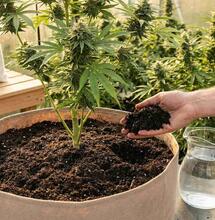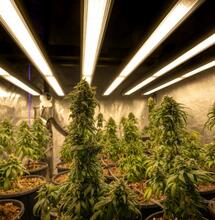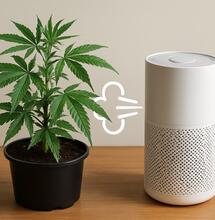Training Outdoor Cannabis Plants for Bigger Yields

If you already have your outdoor plants growing this year and are wondering how to maximise yields, consider plant training. As a beginner grower, you may not be aware of the different cannabis plant training techniques, how to apply them, and the correct time to do so. In this article, I will explain all you need to know to help you on your way to bigger yields.
What Are the Benefits of Training Outdoor Cannabis Plants?
Training cannabis plants is easy to do, and there are many benefits associated. Below is a breakdown of why you should start training your outdoor cannabis plants and the positive effects that doing so will have.
Training changes the shape and structure
Cannabis plants are phototrophic species, so they will naturally want to grow one main central crown cola surrounded by side branches. Applying training techniques at the right time can help alter the shape and growth structure of your outdoor plants, making them shorter and bushier and producing more shoots within a set grow space.
Produces bigger yields
The more shoots and foliage your plants can produce during the vegetative stage, the more productive they will become once they flower. Plant training techniques, such as topping and LST, can significantly enhance the number of potential flowering sites, leading to increased yields.
Stronger side branches and the stem
Cannabis plants exposed to strong winds can become tougher and durable as a way of adapting to their environment. When using plant training techniques such as super cropping (stem snapping), low-stress training and bamboo canes for support, cannabis plants have an opportunity to become far more durable, resulting in thicker and stronger side branches and a larger stem.
Better light penetration
You may think that the sun will provide more than enough light for your outdoor plants; however, using techniques such as tying down will increase the amount of light that the top canopy is exposed to. The more light that can enter the plants, the better!
Increased airflow
One thing about outdoor cannabis plants is that they have a tendency to become thick and bushy when left to their own devices. Pruning and defoliation can help eliminate the lowest growth, enhance airflow, and enable plants to focus their energy on the most crucial top growth.
What Equipment Will You Need?
If you are willing to give cannabis plant training a go, then you will not have to worry about spending high amounts of money on tools and equipment. Below is a list of the items you will need to get started.
- Gardening wire (LST)
- Pair of sharp scissors (topping, fimming, pruning)
When Is the Right Time to Start Training Outdoor Plants?
When growing cannabis outdoors, your plants will enter different stages during their lifecycle, which are the seedling stage, the vegetative stage and the flowering stage—knowing the right time to apply training and when not to make a massive difference in how successful you will be. Below is a breakdown of the different stages, along with key considerations.
The Seedling stage:
This is the stage when your seeds first emerge from the growing medium and produce cotyledons and the first set of true leaves. Cannabis seedlings are delicate, and no training should be applied at all until they enter the vegetation stage after 2-3 weeks of growth.
The Vegetation Stage:
The point at which cannabis plants focus on growing a strong stem, fan leaves, axillary shoots, and establishing a healthy and robust root system. The vegetative stage outdoors will typically last from May until the middle of July when cannabis training techniques are most effective.
The Flowering Stage:
When outdoor cannabis plants begin to flower, they will transition by stretching as tall as they can before producing pre-flowers. However, with pruning and defoliation, Growers should target the third week of flower production as the best time to defoliate. This gives your plants enough time to recover and produce healthy buds for the remaining weeks of flowering, as advised by 420-Seeds.
The 5 Different Cannabis Plant Training Techniques to Apply
You will have the choice to apply five different plant training techniques to your outdoor crop; however, you may not need to use all five, depending on the desired outcomes. Below is an explanation of each method, along with its purpose.
Topping Technique
Topping, also known as pinching out, involves cutting away the growth above an internode with a pair of sharp scissors, thereby exposing the two small growth sites, known as axillary shoots. Applying this technique causes the plant to produce two crown shoots instead of one and will help reduce plant height.
Fimming Technique
The fimming technique involves cutting away the top shoot, similar to topping, but leaving behind 25% of the leaves. The plants will respond by temporarily redirecting their energy to the foliage beneath, producing a denser canopy, which will last until the top shoot regrows to normal within 5-7 days.
Super Cropping
An excellent way to produce extra-strong side branches and stems is to apply the super cropping technique. The way this technique works is by purposely breaking the inner cell walls of the branch. As a result, growth hormone is distributed to the break, and a hard, wooden knuckle will form, typically taking 7-10 days to heal fully.
The Low-Stress Training Technique
LST, or tying down, is a way to produce a laterally dominant growth structure. You will tie the tallest part of the plant down by 6-9 inches or tie a side branch down horizontally. MSNL recommends waiting until the second or third node develops before tying down, as the root system is still too flimsy to anchor the plant before this stage.
Pruning / Defoliation
Using a sharp scalpel or a pair of scissors, pruning involves simply cutting away the plant's foliage. Fan leaves, side shoots and even side branches can be cut away. This technique is also referred to as lollipop pink. It produces a top-heavy canopy that allows the plant to focus all its energy on uniform, large-sized buds, eliminating the concern of low-down, smaller, popcorn-sized buds.
Training Photoperiods vs. Training Auto-Flowering Cannabis
Auto-flowering cannabis plants are ideal for outdoor growers. Autos will automatically flower after 28-35 days of vegetative growth, regardless of the time of year. Planting auto flowers outdoors is an excellent way to harvest a top-quality crop within 11 weeks of planting, continually. Autoflowers are tough, resilient and discreet plants.
When it comes to training auto-flowers, you will only have a set window from weeks 2-4 to apply any plant training. You should also consider the recovery time. Below is an explanation of what training techniques are best for growing autoflowers.
Topping
Topping works well with autos; however, in some instances, plants that are not exposed to a lot of sunlight or planted in small-sized pots (10 litres or below) may end up short and remain between 30-45 cm in height by harvest time.
Fimming
I would avoid fimming autos, as it will only harm the plant's growth and may cause a short and stunted plant. It is best to apply the fimming technique to photoperiods only.
Super cropping
Snapping stems is a high-stress technique that only well-developed and robust plants can handle. Given the short growth period for autos, it is best advised not to apply super cropping.
Low-Stress Training
LST is the best bet to help increase yields and produce more growth sites before the flowering stage. As the name suggests, the plants will not experience a high level of stress and can recover much faster.
My final Thoughts
I am a big fan of cannabis plant training techniques. I have found that when applied at the correct times, it can dramatically increase yields and allow a grower to maximise their grow space. Use the training techniques only during the vegetative stage, apart from defoliation, which can be done as late as week 3 of the flowering period. Take extra care with autos to avoid producing short-statured plants and causing excessive stress.



